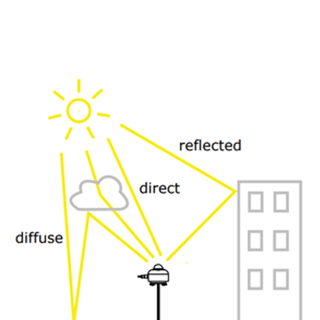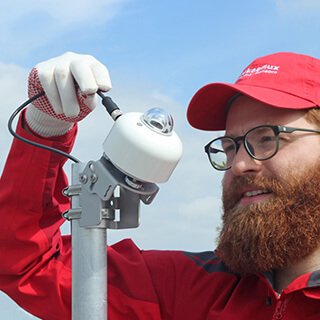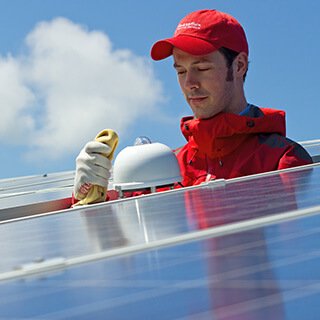Using solar radiation sensors in building automation research
In a constantly evolving world facing rapid changes, it is becoming increasingly crucial for us to be conscious of our energy consumption and its impact on the environment. That is why, in building physics, it is significant to design houses that are energy-efficient or even zero-energy. This article explores the vital role of solar radiation sensors like pyranometers and pyrheliometers in research to enhance building climate control.
An important term when discussing this topic is solar gain. This simplifies the calculation of all the heat entering the building, especially via solar radiation. We describe how to use this term when designing a building to be more energy efficient. Then, we will look at the different types of solar radiation sensors used in research to help control the climate in buildings. Finally, we give a few useful tips to make your own house more energy-efficient and environmentally friendly.
Zero-energy buildings
With a growing global population, it is crucial to be mindful of the energy we consume. Buildings consume 40 % of the fossil fuel energy in the United States and the European Union. That is why the EU has implemented energy requirements for new buildings. Since 2020, buildings have to be nearly zero-energy, and after 2030, they even have to be net zero-energy. For zero-energy buildings, this means that the building cannot have a carbon footprint. All the energy it uses, must come from renewable energy sources on the property itself.
There is also an effort needed to make the building high-energy efficient. Nearly Zero-Energy Buildings (nZEB) are the first step to a climate-neutral society. nZEBs are not only good for the environment, but also decrease the energy cost for the building owner. Of course, the ultimate goal is building Zero-Energy Buildings (ZEB). While there have been many efforts to achieve nZEB’s, there is still a long way to go. That is why research using solar irradiance sensors is so important.
These new regulations require buildings to become smarter in their energy usage. As shown in Figure 1, space heating is the main energy user in an EU household, followed by water heating, lighting, and electrical appliances.
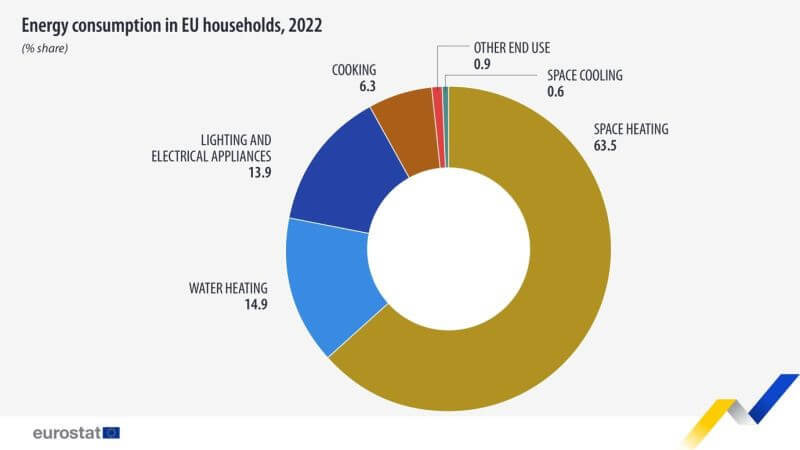
Evidently, space heating is where we have the biggest opportunity to decrease energy consumption. What better way to make it more efficient than by using natural heating? An important concept when talking about the natural heating of a building is solar gain.
Solar gain
Solar gain is the heat gain of a building from solar radiation. This heat transmits into a building via the walls and the roof, but mostly directly through openings like windows. Not only does the amount of solar radiation play a role, but also the material it passes through. Some radiation gets reflected; how much depends on the type of material. Windows transmit more radiation, while walls transmit less of it indirectly. The heat that the walls receive on the outside, is transferred through via thermal transmission. Thermal transmission is the heat transfer through matter. This concept is also important when considering the heat going in and out of a building. An example of limiting thermal transmission is isolating walls.
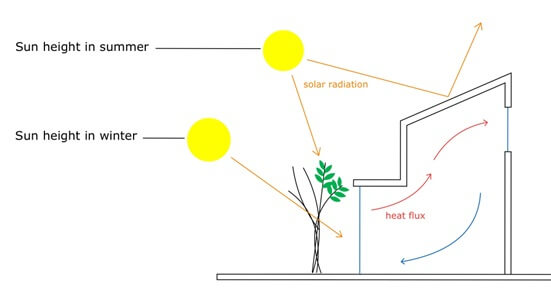
The solar gain a building receives depends on many factors: the incident angle and the wavelength of the sunlight, the types of windows used, etc. Passive shading can decrease solar gain when needed. This type of shading is always in place and does not change depending on the sun’s position. For example, use the height of the sun during the summer and winter to your advantage, as seen in Figure 2. The roof blocks the sun during the summer. In the winter, when the position of the sun is lower, the sunlight can pass through the window. Planting a tree can also provide shade in the summer but lets the solar radiation through in the winter when it has lost its leaves. Active shading systems, on the other hand, can change position and control how much light they let through.
All these factors make it difficult to calculate solar gain. That is why we need to define a more simplified term. In Europe, the solar gain through a window is expressed by the g-value. The US uses the term Solar Heat Gain Coefficient (SHGC), which is more or less the same thing. The g-value and the SHGC both vary between 0 and 1. A value of 1 indicates a window that transmits all the solar radiation, while 0 indicates a window that transmits no solar radiation.
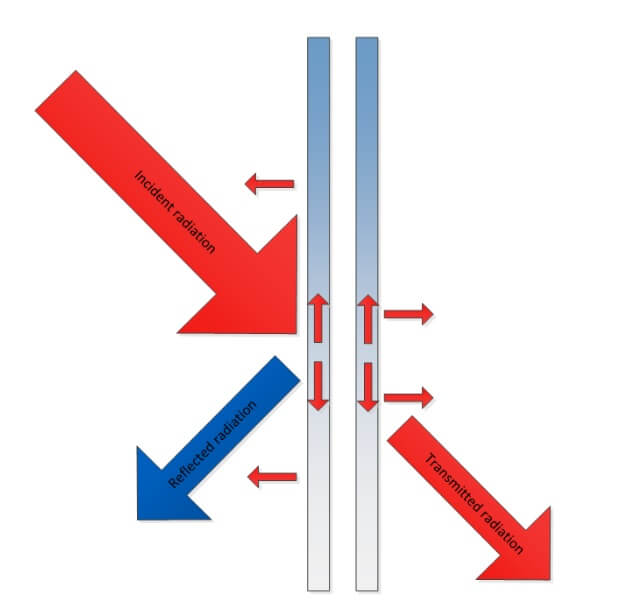
The small arrows represent absorption and conduction.
A typical window transmits more than 50 % of solar irradiance into the building. During the winter, this can help heat the house. But during the summer, we want to limit solar gain to reduce energy usage for cooling. The solution may seem simple: just add shading to your windows. But it is not that simple, unfortunately. Adding shading will decrease the light entering your building. Due to this, more artificial light needs to be used, increasing electricity usage.
Complicated, right? That is why automating building climate control is so important. An automated system can consider all the different factors to make an informed decision. The data from solar irradiance sensors can provide important information for building automation. More on that in the next paragraphs.
Solar radiation in research
Zero energy buildings are important for the future, but right now not entirely realistic. There is still a lot of research needed in this field. Solar irradiance sensors are primarily used for energy-efficient buildings in this research.
In most cases, research has to be as accurate as possible. However, the solar gain and received solar radiation in general can vary in some places. That is why a more accurate result can be achieved when using multiple solar radiation sensors, instead of just one highly accurate sensor. This creates a demand for sensors that are affordable and easy to use.

direct and diffuse radiation, reaching a pyranometer.
Our solar radiation sensors measure three different components of solar radiation. When talking about all the solar radiation received on a horizontal surface, we talk about Global Horizontal Irradiance (GHI). This irradiance consists of two parts: the direct and diffuse irradiance. The Direct Normal Irradiance (DNI) is the radiation received directly from the sun. All the other irradiance is scattered by other objects like clouds and air molecules, which is the Diffuse Horizontal Irradiance (DHI).
The GHI seems the most important, but diffuse irradiance is equally crucial. During the day, most direct irradiance is absorbed by the roof, instead of going through the windows. Almost all of the radiation transmitted through a window is diffuse. But how do you measure these different components? Keep reading to find out.
Much research is done by constructing full-scale test facilities. An example is the PASLINK Network. It started as a project of the European Union in 1985 to develop and improve test methods and analysis procedures. PASLINK does this under real dynamic outdoor conditions. The project was focused on the development of the test cell facility portrayed in Figure 5. Nowadays, PASLINK test cells are widely used in research for zero-energy buildings, mostly modified to fit the research objective.
What solar radiation sensors to use
Solar radiation sensors play a crucial role in controlling the solar gain going into a building. However, there are many types of solar sensors. At Hukseflux, we offer a wide range of solar sensors. How do you choose the best one? We have listed a few useful sensors below.
1. Pyranometers
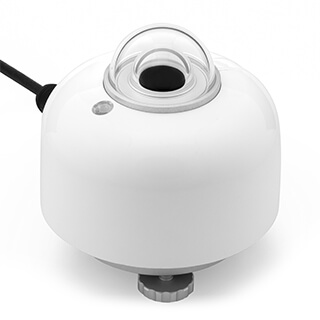
industrial pyranometer.
A pyranometer measures the Global Horizontal Irradiance (GHI). It does this by transferring the incoming radiation into heat via a black thermal sensor. For more information about pyranometers, see our article: Pyranometers: all you need to know.
The measured solar radiation can be used to calculate the solar gain a building receives. That is why the systems described above mainly use a pyranometer. Hukseflux offers multiple types of pyranometers in all three accuracy classes (A, B and C) defined by the ISO 9060 classification system.
Our newest pyranometers are the SR300-D1, SR200-D1 and SR100-D1, designed for industrial environments. The SR300-D1 is the most accurate one. However, when measuring at multiple locations, the SR100-D1 is a good choice. It is a spectrally flat Class B pyranometer, while still providing the surge protection like the SR300-D1.
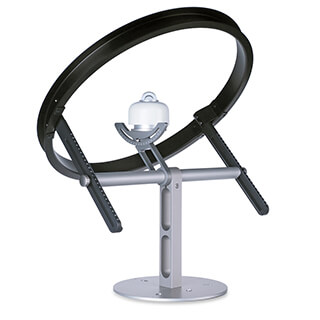
To measure the diffuse solar radiation, use a ‘diffusometer’. This is a pyranometer combined with a shadow ring, see Figure 7. The shadow ring blocks the Direct Normal Irradiance. The Hukseflux SHR02 shadow ring is a low-investment alternative for a sun tracker with shading disc.
2. Pyrheliometers
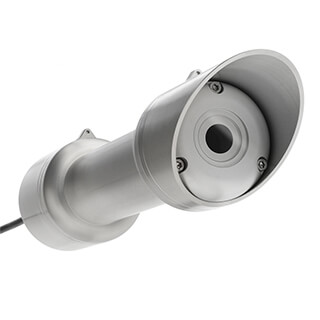
A pyrheliometer measures the Direct Normal Irradiance (DNI). This sensor is mainly used in solar monitoring to monitor the performance of PV plants or in weather and climate studies. It can also be used to measure the sunshine duration. A pyrheliometer is a useful addition to the measurement of a pyranometer when accuracy is needed. That is why it can be less necessary on houses and other buildings that only aim to be more energy efficient. However, in research on zero-energy buildings, it is definitely important.
Hukseflux offers three types of pyrheliometers: the DR30-D1, DR20-A1 and DR15-A1. The DR30-D1 pyrheliometer is a high-accuracy, digital Class A sensor, that provides the best DNI measurement. It is equipped with a window heater, leading to high data availability.
3. Heat flux sensors on the wall
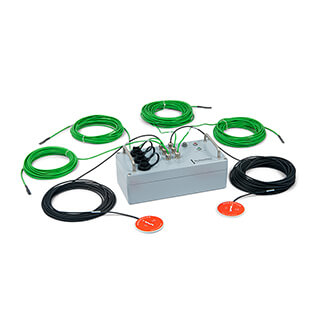
thermal measuring system.
As mentioned at the beginning of the article, thermal transmission also plays a big role in the heat loss and gain of a building. This heat flux can be measured using heat flux sensors on the wall. For more information on this topic, visit our article: Heat transfer through a wall and insulation of a wall.
Our TRSYS20 thermal resistance measuring system is the ideal choice for measuring thermal transmission. It is equipped with two heat flux sensors, two pairs of temperature sensors, and high-resolution electronics, providing the most accurate measurement.
Realistic strategies to improve power usage
As said before, solar irradiance sensors can help the automated system by providing useful data. However, incorporating a bunch of solar irradiance sensors in your own house is unrealistic. That is why we have compiled a few more realistic tips to decrease your power usage or make it more environment friendly. These tips not only help you make your heating and cooling systems more eco-friendly, but also other energy users like lighting.
Automated lighting
The first step is using energy-efficient lighting like LED lights, but there are other ways to minimise energy usage. Simple motion sensors can help control the lighting in your house. When there is no movement detected, the lights turn off. Or use a timer on your lights so they turn off after a certain time. External lighting can be controlled with simple light sensors to detect sunrise and sunset.
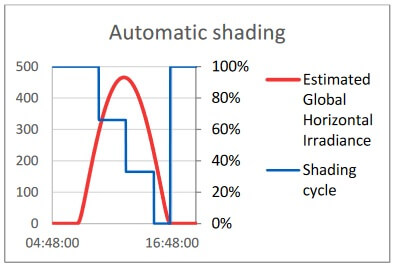
shading system.
Active shading systems
When there is an automated system for shading in place, it can help decrease the solar gain during the summer. A well-known example: blinds that go down when the sun falls through the window. By shading only when the sun is inconvenient, it limits extra power usage from light sources in the building. In Figure 4, you can see an example of the cycle of an active shading system.
PV system monitoring
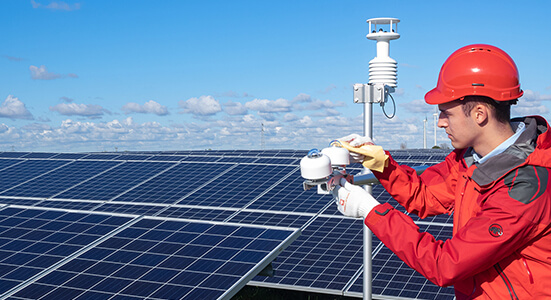
PV panels are one of the most important renewable energy sources. They can provide an easy and effective way to produce electricity, especially for buildings and houses. They can make your house a lot more energy efficient. In big PV systems, pyranometers are used for the solar monitoring, see Figure 11.
Load shifting / thermal accounting
Load shifting does not only decrease energy usage, but it also decreases costs. It distributes the energy consumption throughout the day. In peak moments, when your solar panels receive a lot of solar radiation, the system can turn on appliances like a washing machine to use the excess energy. Energy usage can also be decreased by using an automated thermal system, for example a Heating, Ventilation and Air Conditioning system (HVAC). It can decrease its power consumption during certain hours, when the house is not occupied.
Others
There are many other useful strategies for decreasing power usage. Some common examples are adding insulation and installing a heat pump. A green roof with plants also reduces solar gain and provides insulation. Even the colour of your house can determine the amount of solar gain it receives. This is because light colours, like white, reflect more radiation than darker ones. The material of the building is even more important to limit heat gain. More dense materials (like natural stone) let less heat through, but also keep the heat better inside.
Our solar irradiance sensors can help you make your building more energy efficient and contribute to a more sustainable world. Contact us if you have any questions or if you are curious about the sensor options for your application.








